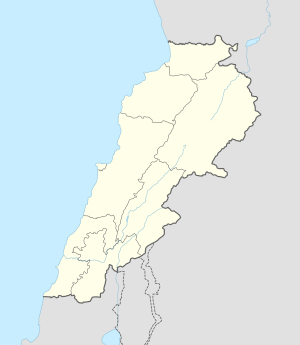Bourj Hamoud
|
Bourj Hammoud برج حموﺪ Պուրճ Համուտ |
||
|---|---|---|

A narrow street in Bourj Hammoud
|
||
|
||
| Location in Lebanon | ||
| Coordinates: 33°53′37.0″N 35°32′25.0″E / 33.893611°N 35.540278°E | ||
| Country |
|
|
| Governorate | Mount Lebanon Governorate | |
| District | Matn District | |
| Government | ||
| • Mayor | Mardig Boghossian | |
| Area | ||
| • Total | 2.5 km2 (1.0 sq mi) | |
| Population (2005) | ||
| • Total | ~150,000 | |
| Time zone | +2 | |
| • Summer (DST) | +3 (UTC) | |
Bourj Hammoud (or Burj Hammud) (Arabic: برج حموﺪ, Armenian: Պուրճ Համուտ), is a town and municipality in Lebanon located north-east of the capital Beirut, in the Metn district and is part of Greater Beirut. The town is heavily populated by Armenians. Bourj Hammoud is a mixed residential, industrial and commercial area and is one of the most densely populated districts in the Middle East.
Bourj Hammoud was founded by survivors of the Armenian Genocide of 1915 and expanded mostly during the 1930s. When the sick and exhausted Armenians who had survived the death marches in Deir ez-Zor (Syria) arrived in Beirut after the collapse of the Ottoman Empire, they were given the right to construct shacks on the eastern banks of the Beirut River that was at the time swamps and marshy lands. They were then allowed to erect houses and buildings which stand to this day. In 1952, Bourj Hammoud became an independent municipality and is currently a member of the Metn-North group of municipalities.
The founding father of Bourj Hammoud and its municipality was the Armenian Catholic Father Paul Ariss (in Arabic الأب بول عريس; in Armenian Հայր Պօղոս Արիս) who was instrumental in laying the foundations of a bustling city and center for the Lebanese Armenian community and served a long time as its mayor. The municipality named a main street in Bourj Hammoud in his name in acknowledgement of his big contributions to the establishment and development of the city.
During its founding and early settlement, Bourj Hammoud was also the focus of a rivalry between two Armenian political parties, the Armenian Revolutionary Federation and the Social Democrat Hunchakian Party, who struggled to control the newly established shanty-town. This led to various altercations and assassinations that gripped the Armenian community of Lebanon. This was climaxed during the Lebanon crisis of 1958, around the time where the two parties and their supporters became polarized due to a religious dispute over which catholicos would be the leader of the Armenian Apostolic Church. However, in the midst of increasing sectarian strife in the late 1960s and early 1970s, Lebanon's Armenian community began to close ranks, and in 1972, the Hunchakian Party ran a joint ticket with the Dashnaks.
...
Wikipedia


